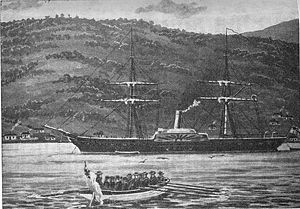 HMS Driver
| |
| History | |
|---|---|
| Name | HMS Driver |
| Ordered | 12 March 1840 |
| Builder | Portsmouth Dockyard |
| Cost | £39,707 |
| Laid down | June 1840 |
| Launched | 24 December 1840 |
| Commissioned | 5 November 1841 |
| Fate | Wrecked on 3 August 1861 |
| General characteristics [1] | |
| Class and type | Driver-class wooden paddle sloop |
| Displacement | 1,590 tons |
| Tons burthen | 1,055 62/94 bm |
| Length | 180 ft (54.9 m) (gundeck) |
| Beam | 36 ft (11.0 m) |
| Depth of hold | 21 ft (6.4 m) |
| Installed power | 280 nhp |
| Propulsion |
|
| Sail plan | Brig-rigged |
| Complement | 149 (later 160) |
| Armament |
|
HMS Driver was a Driver-class wooden paddle sloop of the Royal Navy. She is credited with the first global circumnavigation by a steamship when she arrived back in England on 14 May 1847.[2][3]
- ^ Winfield (2014), p. 160.
- ^ History Channel: This day in history - May 14 Archived 13 May 2008 at the Wayback Machine
- ^ "Arrival Of The Driver Steam-Sloop From New Zealand". London Standard. p. 4 – via British Newspaper Archive.
